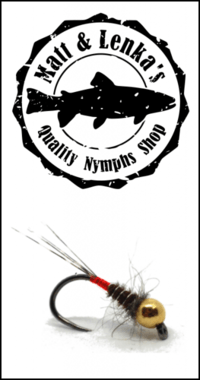After so much effort and a whole bunch of well-thought strategies, there is nothing more frustrating than losing a trout just a few inches off the net while everything announced a happy ending. The hook off is often assigned to defect in the gear and often to the hook itself. But it can actually be caused by multiple mistakes from the fisherman himself. In this article, we give you an overview of the main parameters to adjust and minimise the risk.
The hook : make the right choice
3 characteristics of the hook must have your full attention :
- The sharpness
The chosen hook must imperatively benefit from a quality sharpening which confers it an important and lasting sharpness. Anyway, if you lose fish in an unusual way with your classic gear, make sure the tip of the hook is still sharp. Sometime, after catching several fish or snags, it can become dulled. It is especially the case while nymphing because of the often contacts with pebbles and submerged branches. In order to check if your hook is still sharp, you can slide its tip on your nail. If the point lines the nail, the hook is dull, and you need to change it.
- The gap
It’s the distance that separates the hook’s point from the shank. This characteristic must particularly be kept in mind for modern nymphing where the bead head size tends to reduce the aperture and affect the capacity to hook into the trout’s mouth. In order to not excessively reduce it, make sure to use fairly open modern hook references and split bead head then you can shift them upwards during the tying, at the opposite of the point. You will also have to make sure not to tie a bead head too big for the size of the hook. The unsplit bead head always takes position straight in the axis of the shank, they are bulkier than split ones. So for an equal bead size, you will prefer to choose a larger hook with a non-extended bead, in order to maintain an adequate opening. For more information, here is what I use, only when I tie nymphs on the Atsuko HNS or SPN hooks that I sell :

- The strength
The hook’s strength must be chosen according to the importance of the constraints that it will undergo during the fights with trout. These constraints essentially depend on the size of the fish caught and the type of river (strength of the current and clutter). The finer the hook is, the more efficiently it enters the mouth of the trout, but the more it tends to open as well during tough fights. It’s all about compromise. If you fish for trout smaller than 20 inches in mountain streams, you can use a fine hook without any problem. While, on the other hand, fishing for large trout in a mighty river or in a clutter environment requires stronger references of iron which won’t open, even during extreme tension in the line.
The rod : choose it wisely
Two essential settings must be taken into consideration when choosing a rod:
- The power
- The action
Obviously, in order to make your decision easier among the multiple references on the market, we suggest you read the Trout & co review protocol that allows to quantify those two essential characteristics for a fly rod and therefore, effectively compare the different models available.
Generally speaking, it is easy to remember that the smaller the fish you intend to catch are, the less powerful the rod will need to be. For any standard trout (from 8 to 15 inches), powers inferior or equal to #3/4 or #4 are more than enough. If you’re looking for bigger salmonids, powers from #4/5 allow a better capacity to handle the fish and give you more confidence during the fight.
About the action, whatever the power, the more moderate a rod will be, the less it will cause hook off. Why? Simply because the absence of hard points during the pull prevent from losing a fish.
Upgrade the quality and the detection of the bite
At this point, we are not the only responsible because the fish comes into play as well. There is inevitably elements that will not be from our control. Some days, fish mood makes the bites short and many are lost. In such circumstances, so we can act in favour of the fly taking and in particular on:
- The presentation
Whatever the technique you’re using, a fly that is naturally drifting, drag free, will lead to a serious take, much more than a dragging fly. In order to limit dragging, the position and how the fly lands on the surface are a must when using a dry fly. If you’re nymphing, the most important setting to avoid dragging is the line tension. You need to keep control of the drift but not restraining the nymphs. I agree it is a very subtle compromise to find. If the banner is too relaxed, trout will take more frankly, but you won’t be able to detect the take, or it will be too late, and the strike will be ineffective (fish not hooked up or lost during the fight). If the banner is too stretched in the other hand, the trout will come straight to the nerve of the rod when she eats the nymph and spit it instantly. The result will be the same, strike will be ineffective, fish missed or lost after a few seconds. However, when the fish is hard to decide, using lighter nymphs and with a bit more banner can increase the quality of the take to your advantage.
- The type of fly
A fly suitable and adapted to the local conditions leads to really good takes. With a dry fly, an approximate imitation not matching the exact hatch will cause the trout to grab the fly with the tip of the noise. It often results in a missed strike, or a lost fish shortly after hooking up.
When nymphing, same story: you need to present a fly in adequacy with the conditions in order to improve the quality of the take.
During summer for example, when the water is low and clear, make sure to not use a fly too big. Unless you’re using terrestrial by the way. But using a fly that is too big may compromise the take. On overfished, hammered sections, where trout are used to see anglers all year round, the flashiest models don’t encourage the fish to take frankly and it seems to be a source of loss during fights.
Upgrade stricke quality
The strike must be realised :
- In the right timing
With euro-nymphing, the short time between when the trout takes the nymph and the moment you strike must be as short as possible. Here, there is no exception, the more reactive you are, the more efficient the strike will be. Holding the rod at the right angle (around 45°) during the drift is a must in order to be reactive.
If you’re fishing with a dry or a small nymph, the situation is different. Even more when you use small flies in slow water, bigger fish tend to slowly take the fly. The risk here is to strike too early and remove the fly from the trout’s mouth. Emotion, when you see a large beak breaking the surface to make disappear your fly brings a reflex strike completely ineffective because the hook doesn’t even hit the fish in most cases. So, you need to wait until the fish dives with your fly in its mouth before striking. With a nymph, and without indicator, intuition is part of the game: you must wait for the trout to completely stop after she went sideways to take your imitation. When it’s possible, wait to see the white of its mouth disappear before strike.
Whatever the technique you are using, bringing back the exceed of line with the left hand during the drift is necessary in order to strike properly.
- With the right amplitude
The strike must have a limited amplitude (roughly between 50 and 70 cm) to avoid the line to break eventually. The amplitude will be adapted according to the situation: with a fast rod, you’ll tend to reduce the amplitude. To obtain this right amplitude, the rod must not be positioned too high during the drift, the ideal angle being 45°.
Manage the fight
Once hooked, and mostly if the fish is quite big, you need to reduce risks as much as you can. If the line undergoes too much tension, you could lose the fish in several ways, for example, by ripping its flesh, or opening the hook. Here is what you need to do to keep your fish on:
After the strike, you need to immediately take position, or stay here you are, downstream from the fish. If the fish rushes downstream, do not hesitate to run and follow it until you are downstream from its position. By staying downstream from the fish, when you will be able to bring it to the net, you can use the current in your favour. Being upstream from a solid fish skating on the surface must remain a rare situation.
For standard size trout (less than 15”) it is possible to bring them upstream, but you need to keep your rod horizontally. This move avoids the trout to stay on the surface facing the current, which would definitely increase the risk of losing the fish. The best way to keep it is to maintain it underwater.
Once you’re positioned downstream from the fish, you need to keep your rod up and straight, in order to absorb the headshakes. It is particularly important when the fish is getting closer to the net because the line’s elasticity is reduced to its minimal which makes the tension on the tippet and hook at its maximum.
At this point, adjusting the line length is a must to ensure the netting. The most common mistake is to keep too much line. It forces the fisherman to pull too much the rod until reaching the vertical position. First the rod doesn’t work properly in this position, which increases a lot the loss of the fish, but it is also dangerous for the tip of the rod.
USEFUL LINKS :

